Celebrating 85 Years
Founded in 1931, Universal Builders Supply, Inc. (UBS) has worked on some of the country’s most recognizable and treasured structures. Each generation of this three-generational company has had a pet project to be proud of, starting with the Empire State Building, one of the few construction jobs in New York City during the Depression, to Yankee Stadium, the Washington Monument, and the Statue of Liberty. To celebrate it’s 85th year in 2016, UBS posted 85 Fun Facts about some of the most iconic and historic building projects. Here they are:
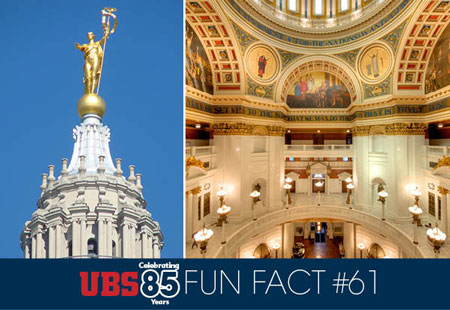
Post 61: Capitol Dome, Harrisburg, PA
Pennsylvania’s Capitol, designed in 1902 and designated a National History Landmark in 2006, is considered one of the best examples of American Renaissance architecture. Located in Harrisburg, it is the seat of Pennsylvania’s government, and is often referred to as a “palace of art” because of its many sculptures, murals, and stained-glass windows. Between 1985 and 1987, UBS erected scaffolding in the Capitol’s rotunda to restore the 94-foot diameter dome, and the murals were also removed for restoration. To reduce the visual impact of a scaffold, while keeping the weight and quantity of equipment to a minimum, UBS used the same high-capacity aluminum structural system as the Statue of Liberty restoration. The gilded brass statue atop the Capitol dome, called “Commonwealth,” was removed for restoration via helicopter in the summer of 1998, and returned in September of the same year.
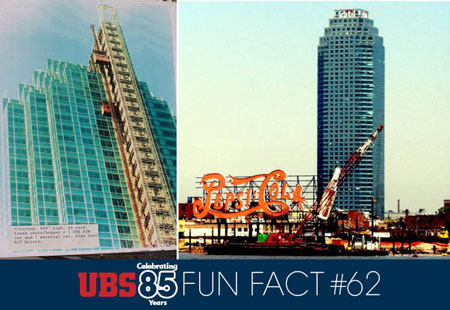
Post 62: Citigroup Building, Long Island City, NY
In 1989, the financial services giant CitiCorp (now known as Citigroup), erected New York City’s tallest tower outside Manhattan in Long Island City, Queens, where city officials hoped to establish a new commercial district. One Court Square, also known as the Citigroup Building, was completed in 1990 by Skidmore, Owings & Merrill LLP. Wrapped in green-tinted glass, the building boasts 27 passenger elevators, four freight elevators, and six escalators. UBS erected a 50-story dual hoist for the construction of the skyscraper.
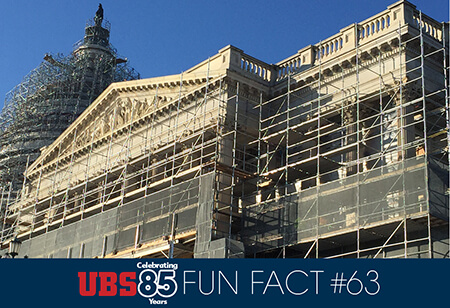
Post 63: United States Capitol, Washington, DC
The United States Capitol in Washington DC, often called the Capitol Building or Capitol Hill, is the seat of the U.S. Congress and one of America’s great symbols of freedom. The nearly 9-million pound dome is currently being restored due to deterioration of its predominantly cast iron structure caused by natural elements. In 2014, UBS designed and built customized scaffolding, which surrounds the north elevation. The entire project (exterior and interior) will be complete and all scaffolding will be removed prior to the Presidential Inauguration in January 2017.
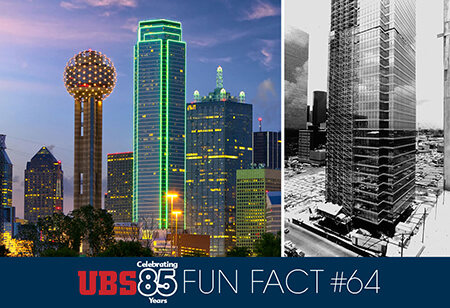
Post 64: Dallas Main Center (Bank of America Plaza), Dallas, TX
The Bank of America Plaza is a 72-story late-modernist skyscraper located in the Main Street District of downtown Dallas, TX. Originally called Dallas Main Center, the building has had five names since its opening in 1985, but is referred to locally as ‘the green building’ due to its green outline lighting that made it an instant icon of the Dallas skyline. The building was upgraded in late 2013, and its 9,000 feet of LED lighting now have full-color and movement capabilities that are turned on for special events. It is the tallest building in Dallas, the third tallest in Texas, the 22nd tallest in the United States, and the 123rd tallest in the world. UBS provided the construction hoist for the building.
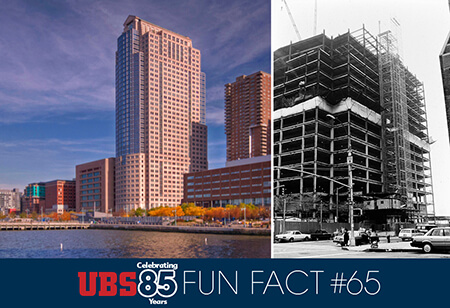
Post 65: 388 Greenwich Street, NYC
UBS provided hoisting during the erection of 388 Greenwich Street, a 38-story skyscraper just north of the World Trade Center in the TriBeCa neighborhood on the Hudson River in NYC. It was originally built as Shearson Lehman Plaza in 1988, and was more recently known as the Travelers Building when a four-story red neon umbrella was mounted near the top of its north-facing side that some found emblematic and others distracting. Sold in 2007, the building forms a complex with the neighboring 10-story 390 Greenwich Street comprising the headquarters of the corporate and investment banking arms of Citigroup. The building is also one of the few in New York to utilize double-deck elevators.
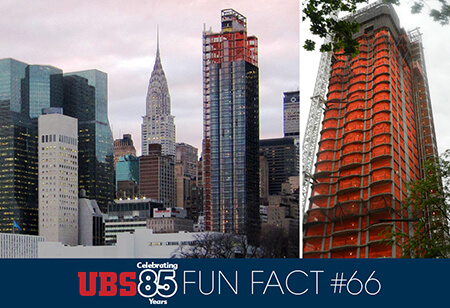
Post 66: 50 United Nations Plaza, NYC
50 United Nations Plaza is a new residential skyscraper located across from the United Nation’s Headquarters in NYC. An iconic addition to the Manhattan skyline, 50 United Nations Plaza is the first residential building in the United States to be designed by the London-based #architecture firm Foster + Partners with famed principal architect Norman Foster. The name of the building goes beyond its proximity to its namesake. In 1946, real estate developer William Zeckendorf Sr. offered the site along the East River to the UN, and with the help of the Rockefeller family, the historic deal was made. Over 60 years later, Zeckendorf Sr.’s grandsons William Lie and Arthur Zeckendorf, in partnership with Ofer’s Global Holdings, purchased the site across the street, and christened it 50 United Nations Plaza in tribute to their paternal grandfather—and to their maternal grandfather, Trygve Lie, who was the first UN Secretary General.
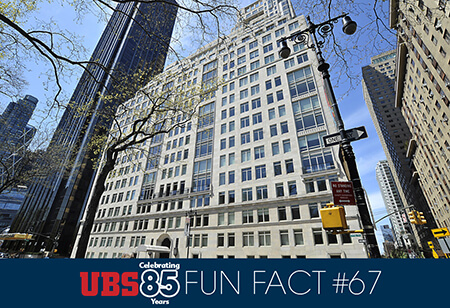
Post 67: The Mayflower, NYC
In 2004, developers Will and Arthur Zeckendorf bought the famed but dilapidated Mayflower Hotel and several adjacent lots with the goal of creating the city’s most exclusive residential building —15 Central Park West. 15 CPW is divided into two sections, a 19-story tower on Central Park West known as “The House” and a 35-story tower on Broadway, joined by a glass-enclosed lobby and considered one of the most exclusive addresses in the city, with residents from A-Rod to De Niro, Sting, Norman Lear, and Denzel. The location, described as “the most expensive site in Manhattan,” comprises an entire, albeit small, city block. It’s limestone façade used material from the same quarry that was a source for the Empire State Building. UBS provided the hoisting for this project that began in 2005 and was completed in 2008.
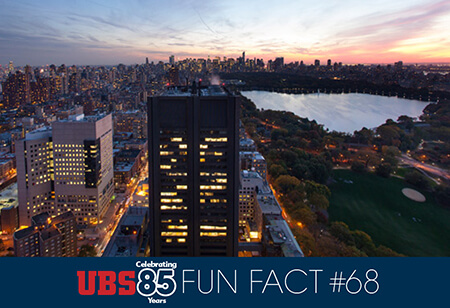
Post 68: Mount Sinai Hess Center for Science & Medicine, NYC
As United States cities grew more crowded in the mid-19th century, philanthropist Sampson Simson founded a hospital in 1852 to address the needs of New York’s rapidly growing Jewish immigrant population. The Jews’ Hospital in the City of New York, as it was then called, soon found itself an integral part of the community so It changed its name to The Mount Sinai Hospital in 1866, to reflect this new-found role. After many moves and expansions, The Mount Sinai Hospital joined with the Continuum Health Partners in 2013 creating The Mount Sinai Health System. Located on the edge of Spanish Harlem and the upper East Side, the campus extends from 98th to 102nd Street. In 2009, UBS provided a dual hoist and overhead protection for the new Hess Center for Science and Medicine, which was completed in 2011. It is envisioned as a place of discovery and healing that unites scientists, clinicians, and educators in a unique and collaborative way.
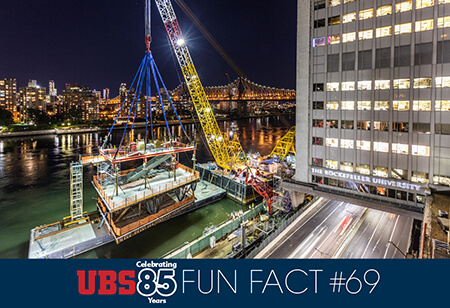
Post 69: Rockefeller University, NYC
Founded in 1901 by John D. Rockefeller, the Rockefeller Institute for Medical Research was the country’s first institution devoted exclusively to biomedical research. The Rockefeller University Hospital was founded in 1910 as the first hospital devoted exclusively to clinical research. In the 1950s, the Institute expanded its mission to include graduate education to training scientists to become research leaders around the world. In 1965, it was renamed The Rockefeller University. Presently, UBS is furnishing access stairwells along the FDR as part of the $500 million expansion, which will see the addition of two acres to its already existing 14-acre campus including the renovation of the East River Esplanade stretching from East 64th Street to East 68th Street along the FDR Drive.
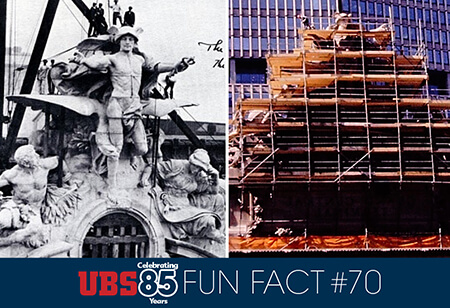
Post 70: Grand Central Terminal's Mercury Statue, NYC
The 48 × 60 foot sculpture weighs 1500 tons, and was the largest in the world at its unveiling in 1914. It sits at the peak of the Grand Central Station façade facing south to 42nd Street, with Mercury on top – the mythical god of transportation and commerce. To his right is Hercules, representing strength and labor; to his left is Minerva, the goddess of wisdom, whose hand is busy documenting the history of the world. Designed by the French sculptor Jules-Felix Coutan, the artist himself never set foot in the U.S. It was carved in pieces by Donnelly and Ricci in the Long Island City yards of William Bradley and Sons, and the group was put together atop the Terminal. Underneath Mercury is the large clock with a circumference of 13 feet, which was the largest piece of Tiffany glass in the world at that time. A little secret regarding the clock – the circle surrounding the roman numeral six is actually a window.
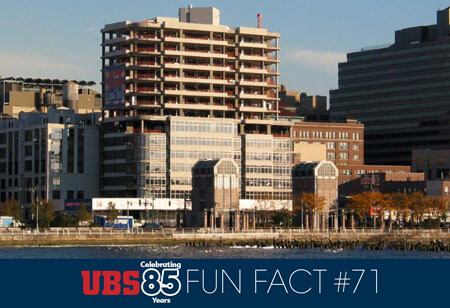
Post 71: 1 Morton Square, NYC
1 Morton Square is a full-block, residential development in the West Village erected in 2004 on a former United Parcel Service parking lot. Comprised of six townhouses, 147 lofts, 135 rental apartments, it totals 283 residences. The West Village, roughly bounded by the Hudson River on the west and 6th Avenue on the east, from 14th to Houston Street, was historically known for its American bohemian culture scene in the early and mid-20th century. In fact, the Village hosted the first racially integrated night club in the United States, when Café Society was opened in 1938 at 1 Sheridan Square by Barney Josephson. In 2003, UBS provided sidewalk bridge and two dual hoists ranging 15 stories for the initial installation of this project.
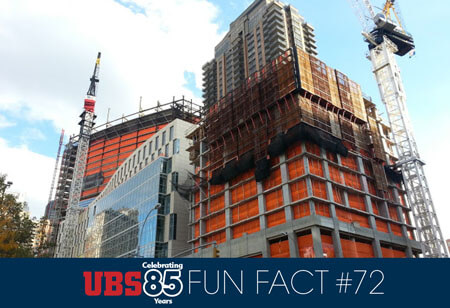
Post 72: Fordham Law School, NYC
Fordham Law School’s Manhattan campus expansion is located just south of Lincoln Center for the Performing Arts. Designed by the reknowned architectural firm Pei Cobb Freed & Partners, it is the centerpiece of the first phase of Fordham University’s 15-year master plan for its Lincoln Center campus. The building creates a new northern boundary to Fordham’s Robert Moses Plaza with three distinct scales: a one-story dining pavilion opening onto the Plaza’s central green; the nine-story Law School, whose gently curved surface frames the Plaza; and the taller but quieter 22-story Residence Hall. In 2012, UBS provided access scaffold and a hoist spanning 23 stories for the expansion of the Law School.
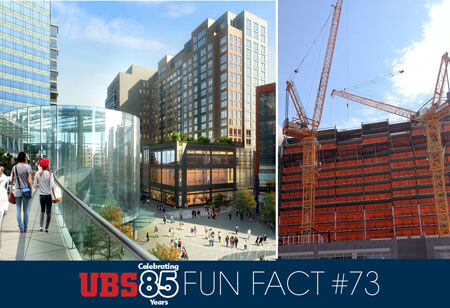
Post 73: Flushing Commons, Queens, NY
Flushing Commons is transforming a 5.5 acre parcel in downtown Flushing—former home to a municipal parking lot—into a dynamic mix of residential housing, commercial space, retail, community facilities, a 1,600 space public parking, and open space. Flushing is a neighborhood in the NYC borough of Queens with downtown Flushing being the 4th largest central business district in NYC. In the 1970s, a wave of immigrants—who were the descendants of former soldiers and political supporters of Chiang Kai-shek and the Chinese Nationalist Party—were the first to arrive and develop what would become Flushing’s Chinatown. Now Flushing is one of the largest and fastest growing ethnic Chinese enclaves outside of Asia, with the racial make-up at 69% Asian. UBS erected two hoists on this project, the Cherry Building hoist served 18 stories. The Douglas Building topped out at the 14th floor.
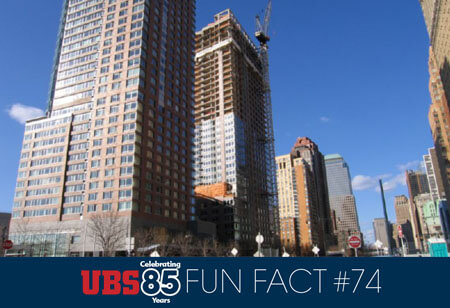
Post 74: Millennium Tower Residences, NYC
Built at the southernmost point of Battery Park City, Millennium Tower Residences overlooks the harbor and the Statue of Liberty with spectacular views. In keeping with Battery Park City Authority’s pledge to create a sustainable community, it is LEED Gold-Certified as a Green Building by the U.S. Green Building Council. The architects Handel Associates designed the building to be 25% more efficient than current NYS standards with solar rooftop panels, fresh ducted air that has been adjusted to filter and remove 85 percent of all outside particulars, soot and airborne toxins, and to use 33 percent less water with on-site recycling of waste water. UBS installed a 36-story hoist in 2005-2006.
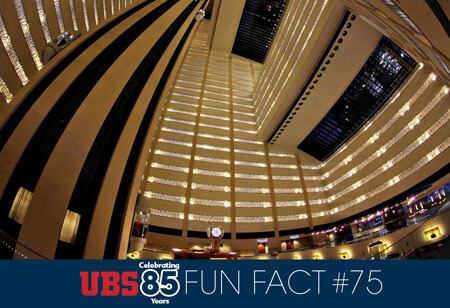
Post 75: New York Marriott Marquis, NYC
The New York Marriott Marquis located in Times Square at the corner of 45th Street and Broadway opened in 1985. Designed by architect John Portman, the hotel is famous for its high-tech elevators and atrium lobby rising 45 stories to “The View”, New York’s only rooftop revolving restaurant and lounge. The View is the third highest restaurant in New York City behind ONE Dine on the 101st floor of 1 WTC, and the Rainbow Room on the 65th floor of 30 Rockefeller Plaza. With 1,949 rooms and over 100,000 square feet of meeting space, it is one of the largest hotels in the city. In 1999, UBS furnished and installed safety netting and work platforms that were lifted into position and raised to the 45th floor to provide access so workers could repair and paint the atrium ceiling.
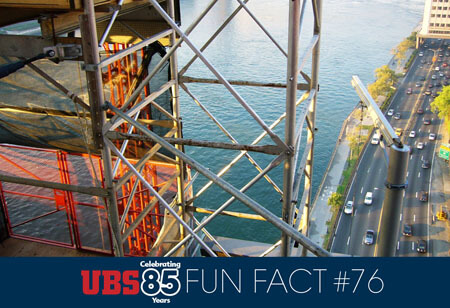
Post 76: New York-Presbyterian Hospital, NYC
The New York Hospital was founded in 1771 by Edinburgh graduate Samuel Bard and became associated with Weill Cornell Medical College. The Presbyterian Hospital was founded in 1868 by James Lenox, a New York philanthropist and was associated with Columbia University College of Physicians and Surgeons. On January 1, 1998, the merger of the two institutions was announced creating New York-Presbyterian Hospital. UBS provided hoisting for construction of the The Morgan Stanley Children’s Hospital in 2001, the Weill Cornell Medical Center on East 68th Street, and NYPH Heart Center on 165th Street in 2007.
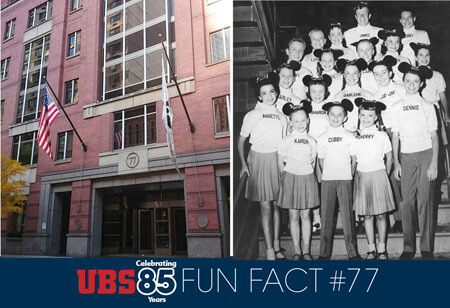
Post 77: Disney/ABC, NYC
The Disney/ABC relationship stretches back to the 1950s when Walt Disney and his brother Roy contacted ABC to finance a park project in exchange for producing a television program. ABC agreed, launching the legendary Sunday night favorite, Disneyland, which debuted in 1954. When Disneyland opened in 1955, ABC aired a special live broadcast commemorating the park’s first day of operation. Shortly thereafter, the iconic children's program The Mickey Mouse Club, began airing weekday afternoons, starring a group of 24 children known as the “Mouseketeers”. In 1996, Disney acquired Capital Cities/ABC making ABC an official part of the cast. Disney/ABC’s headquarters are located on 66th street between Columbus and Central Park West. In 2014, UBS installed suspended scaffold to access the ceiling for a sprinkler system installation at 77 W 66th Street.
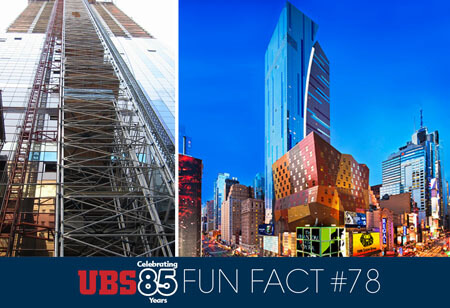
Post 78: The Westin NY Times Square, NYC
Built in 2002, The Westin New York at Times Square made headlines with its eye-catching but controversial design by Miami-based firm Arquitectonica. The complex curtain wall of 10 colors materialized as 8,000 glass panels with so little repetition in color or form that the parts had to be labeled with a bar code at the factory for construction crews to know where to place them. The curtain wall that covers the 47 floors of the building changes colors throughout the day as they are reflected in the sky, the sun, and clouds. The basic rectangular prism is sliced in two by a curving beam of light, as if a meteor had just landed on 42nd Street. In 2001, UBS erected two dual hoists soaring 47 stories above Times Square.
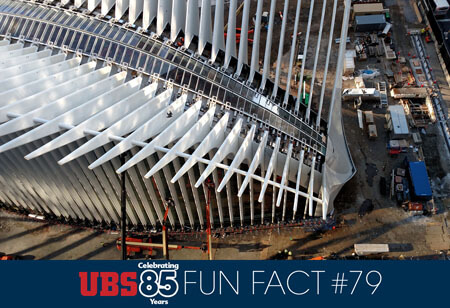
Post 79: WTC Transportation Hub, NYC
In 2003, Daniel Libeskind designed a master plan for the post 9/11 WTC site that called for an Oculus space to be left open, forming a “Wedge of Light” so that sun rays around the autumnal equinox would hit the World Trade Center footprints each September. In early 2004, the Port Authority, which owns the land, modified the plan to include a large transportation station downtown, intended to rival Penn Station and Grand Central Terminal. In a nod to the Libeskind concept, the Spanish architect Santiago Calatrava retained the Oculus concept in his design for the WTC Transportation Hub saying it resembles a bird being released from a child’s hand. Applauded for its spiritual and aspirational dimension, it soon became plagued by budget and engineering issues causing design modifications. Construction began in 2006, with the last construction crane removed in December 2015. UBS played a small role in this project, providing hanging decks and access scaffold for workers in the early stages of the installation.
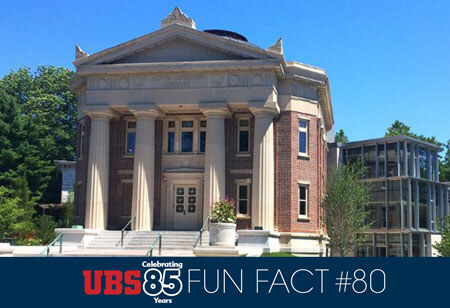
Post 80: John Jermain Memorial Library, Sag Harbor, NY
Major John Jordan Jermain, born in White Plains, New York in 1758, served in the Westchester Militia during the American Revolution. Following the war, he moved to Sag Harbor, a whaling village on the East End of Long Island, and married Margaret Pierson of Bridgehampton, New York. Together, they had nine children. His granddaughter Margaret Sage organized the effort to fund and build the John Jermain Memorial Library in Sag Harbor in honor of her grandfather in 1910. Designed by Augustus N. Allen in The Classical Revival style, the library regally oversees a corner on Main Street across from the Whaling and Historical Museum. UBS provided scaffolding a four-year restoration and expansion project completed in July 2016.